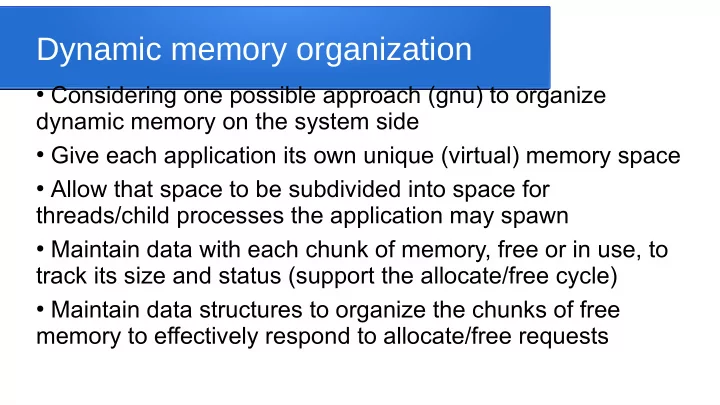

Dynamic memory organization ● Considering one possible approach (gnu) to organize dynamic memory on the system side ● Give each application its own unique (virtual) memory space ● Allow that space to be subdivided into space for threads/child processes the application may spawn ● Maintain data with each chunk of memory, free or in use, to track its size and status (support the allocate/free cycle) ● Maintain data structures to organize the chunks of free memory to effectively respond to allocate/free requests
Arenas ● Each application given an “arena”, which controls the memory space for that application ● Arena has it’s associated memory stored in chunks in a heap (it controls division into chunks) ● Arena can subdivide its space into smaller arenas (e.g. use a chunk of its heap to create an arena for a child process) and/or smaller heaps (i.e. use a chunk of its heap to create another, smaller heap, for another purpose)
Heaps ● Heap is section of memory, divided into chunks, each of which can be either free or allocated to application ● Heap can divide chunks into multiple smaller chunks, or coalesce adjacent free chunks into a single larger free chunk as needed ● Big “top” chunk of memory on heap kept free as long as possible, for cases when allocate requests can’t be satisfied from the other chunks
Chunks ● Allocated chunks need to have the space the user requested, plus administrative data to support allocation and free operations ● Free chunks mostly empty, but part of space needs to be used for similar administrative information ● Admin info usually at beginning/end of chunks, so they are easily accessible by allocate/release routines
Allocated chunk admin data ● At start of chunk: Size (bytes) ● Flag indicating which arena controls it ● Flag indicating if directly memory mapped (biiiig chunks) ● Flag indicating if preceding chunk is free or not ● ● Followed by user content
Free chunk admin data ● At start of chunk: Total size of chunk ● Arena flag ● Is it memory mapped ● Is preceding chunk free or not ● Pointer to next chunk ● Pointer to previous chunk ● ● Most of chunk is unused while free ● At end of chunk: Size (again) ●
Recommend
More recommend